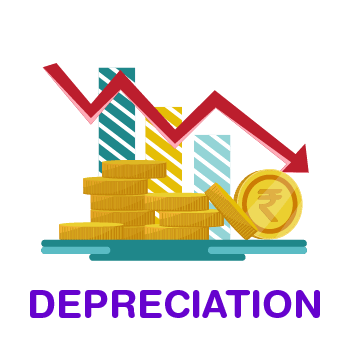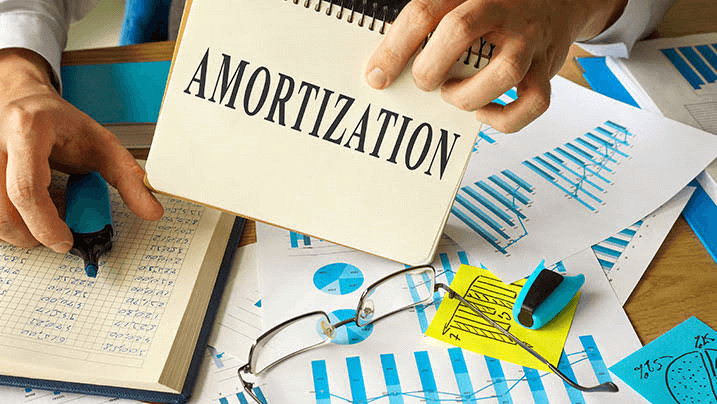Difference between Depreciation and AmortizationA property may have a long functional life when it is acquired by a corporation. Whether it's a company car, goodwill, the corporate office, or a patent, the asset may be useful to the business over time rather than simply when it's obtained. The cost of business assets can be deducted annually over the asset's life in order to more properly reflect how they are used. After that, the cost amounts are put to use as a tax deduction, which lowers the company's tax obligation. The two primary ways for determining the worth of such assets are amortisation and depreciation, with the kind of asset being expensed serving as the primary distinction between the two approaches. Also, there are variations in the techniques that are permitted, the elements of the computations, and the way that they are displayed on financial statements. Depreciation
Depreciation is a term used in accounting to describe two related concepts: first, the actual decline in an asset's fair value over time, such as the value of factory equipment declining annually as it is used and wears out; and second, the allotment in accounting statements of the asset's initial cost to the periods during which the asset is used (depreciation with the matching principle). Depreciation is the process of reallocating, or "writing down," the cost of a material object (such as machinery) over the course of that asset's useful life. It also refers to the decline in asset value. Long-term assets are depreciated by businesses for accounting and tax reasons. A company's or entity's balance sheet is impacted by the asset's decline in value, and its income statement is impacted by their method of accounting for the asset's depreciation, which has an impact on net income. The cost is often divided up as depreciation among the intervals when the asset is anticipated to be employed. For tax purposes, depreciation methods and the time frames over which investments are depreciated may differ depending on the type of asset and the firm. Laws or accounting rules, which may differ from nation to country, may specify these. Depreciation expense can be calculated using a variety of approaches, including declining balance, straight line, and fixed percentage. When an asset is put into use, depreciation expense often starts. A 500-dollar item, for instance, might incur a 100-dollar depreciation expenditure every year for five years. Depreciation is a non-cash expense that is defined as the decline in an asset's utility or value. That simply means that now the asset is no longer worth as much as it once was, with no corresponding cash outflow. Wear and tear from everyday life are depreciation causes. It is necessary to subtract the necessary costs from the activity's earnings in order to calculate the net income (profits) from that activity. The cost of resources used but not instantly consumed in the operation is one such expense. The such cost assigned in a given time period is equal to the asset's value being deducted from its original value, which is equal to the price paid for the asset at the time of purchase and may or may not later be connected to the price anticipated to be obtained upon its sale. Depreciation is any technique for distributing this net cost to the times when the company expects to gain from using the asset. Depreciation is the process of subtracting an asset's cost over the course of its useful life. Each class in which assets are categorised has their own useful life. The asset is known as a depreciable asset. Despite the fact that depreciation establishes the asset's value on the balance sheet, it is technically an allocation method rather than a valuation. Any business or income-generating endeavor that makes use of tangible assets is subject to costs associated with those assets. Some of these expenditures must be delayed rather than recorded as a current expense if an asset is anticipated to generate benefits in subsequent periods. The company then allocates the cost of depreciation for the current period in its financial reporting. Often, this is carried out in a methodical and logical way. Four criteria are typically included in this:
Depreciable basisCost, which includes all expenses associated with obtaining and putting an item into use, is often the price paid for the asset. Valuation method may be disregarded in specific locations or situations. Several nations' regulations outline the lives and procedures to be followed for particular asset kinds. Yet, in the majority of nations, life is founded on commercial experience, and the approach can be chosen from a range of legal options. Depreciation over timeIn accordance with most accounting principles, depreciation expense is typically recorded in a different fund and shown as accumulating under fixed assets on the balance sheet even though it is reported on a company's income statement. Because cumulative depreciation separately displays a negative amount that is closely related to the accumulated depreciation account on the balance sheet, it is known as a contra account. The relevant asset is often directly charged with the depreciation expenditure. Even if no assets have been acquired or sold by the company, the valuations of the fixed assets shown on the balance sheet would decrease. The sums should be close to fair value, theoretically. Depreciation expense is otherwise subtracted from accumulated depreciation. The effect of keeping the cost model of assets on the balance sheet is achieved by showing accumulated depreciation separately. The valuations of the financial assets for the current year and the prior year (P/Y) will be equal if there were no investments or dispose of fixed assets for the year. Illustration of DepreciationAn example of depreciation is the sum-of-the-years digits approach, which accelerates the depreciation of tangible assets like vehicles. A corporation recognizes a larger amount of depreciation expense under the sum-of-the-years-digits method in the initial years of an asset's life. Theoretically, since modern assets are more effective and in demand than older ones, more cost should be incurred during this period. Amortization
In accounting, amortisation means systematically depreciating the acquisition cost less the residual worth of intangible assets over the course of their approximate "useful economic lives" to reflect their intake, expiration, unsustainability, or other value loss due to use or the passing of time. For tangible assets, depreciation is a similar idea. The methodologies used to assign amortisation to every accounting period are often the same as those used for depreciation. Yet, certain intangible assets, like as goodwill or specific brands, may be judged to have an infinite useful life and are thus not subject to amortisation (although goodwill is subjected to an impairment test every year). Although in theory amortisation is used to account for an intangible asset's declining value over its useful life, in practise many businesses will amortise costs that would otherwise be one-time expenses by classifying them as capital expenses on the statement of cash flows and paying off the expense through amortisation. This practise has the benefit of increasing the business's net income in the fiscal year or quarter in which the expense is incurred. An entity's financial statements reflect amortisation as an expense on the income statement and as a decrease in the carrying amounts of the intangible asset on the balance sheet. IAS 38 of the International Financial Reporting Standards provides guidelines on how to account for the amortisation of intangible assets. The main guidance under the generally accepted accounting standards (GAAP) in the United States is found in FAS 142. Illustration of AmortizationA business may spread out the expense of a patent throughout the course of its usefulness. Consider a scenario in which a corporation holds the sole rights to a patent for ten years with no option for renewal. The business may spread out the cost of the patent over ten years, reimbursing 10% of the costs per year. The bearing value of the trademark lowers due to amortisation. Differences between Depreciation and Amortization
Why Do We Amortize Loans Rather Than Depreciate Them?Since that loans are intangible, they are amortised. Unlike actual assets, which lose value or wear down with time, loans do not. Loans are also amortised because the initial asset value is largely irrelevant for financial reporting purposes. Despite the possibility of payment history being contained in the notes, a corporation simply needs to disclose its present amount of debt rather than the previous value less than a contra asset. How Can I Tell If I Should Amortize or Depreciate an Asset?In general, there is accounting guidance provided by GAAP on how to handle various asset categories. Accounting regulations mandate that tangible, physical assets should be depreciated whereas intangible assets should be amortised (with the exception of non-depreciable assets). Amortization vs. Depreciation: Which Is Better for an Asset?Depreciating or amortising an asset has no clear advantages. The correct way to amortise or depreciate an asset is determined by accounting advice, not a general rule. Both terms stretch the cost of an asset across the course of that asset's useful life, and neither one provides a corporation with a financial benefit over the other. ConclusionThe benefit of an asset and its related expenditures are reflected over time using two popular ways. Depreciation and amortisation both lower an asset's carrying value and record expenses as they are used up over time. Nonetheless, physical assets are subject to depreciation, but intangible assets are subject to amortisation. Also, there are variations in the techniques offered, acceleration choices, the application of salvage value, and the use of contra accounts.
Next TopicDifference between
|
 For Videos Join Our Youtube Channel: Join Now
For Videos Join Our Youtube Channel: Join Now
Feedback
- Send your Feedback to [email protected]
Help Others, Please Share










